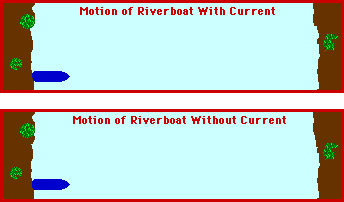The River Boat
Observe the motion of the river boats below. In each case, the boat is heading across the river. In the top case, the presence of a current causes the boat to travel downstream as it simultaneously moves across the river; the result is that it reaches the opposite shore at a point downstream from where it started. In the bottom case, the absence of a current means that the boat moves straight across the river; it ultimately reaches a point on the opposite shore directly across from where it started. It is important to note that the current is what carries the boat down the stream; it is not the motor of the boat that provides its downstream motion.

Assuming that in each case the motor of the boat propels it across the river with the same force, in which case (with or without a current) will the boat make it across the shore the soonest? Make your observation in the above animation to find out. You might be surprised by your observation.
For more information on physical descriptions of motion, visit The Physics Classroom Tutorial. Detailed information is available there on the following topics:
Vectors
Vector Addition
Resultant
Pythagorean Theorem and SOH CAH TOA
Riverboat and Relative Velocity Problems
Independence of Perpendicular Components of Motion